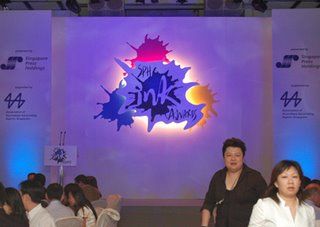Wednesday, August 30, 2006
Is online mag given the flick before it began?
Turns out the mag has been sued by Hills Creative Arts (owners of TAXI Design Network) for copyright infringement and has been shut down.
Hills Creative Arts took offence at Flick’s website and media kit which carried a few lines of material describing Flick’s business, which was apparently copyrighted on www.designtaxi.com.
I spoke to the owner of Flick Design’s website, Kyle Neo, who has had to issue email apologies to TAXI to his contacts, and has had to bear damages and TAXI’s legal costs.
Neo said the material was submitted to him by contributors and he was unaware it was copyrighted material, and wished TAXI had contacted before taking legal action.
He sounded dejected but brave, and will now concentrate on his online design business while contemplating the viability of re-starting Flick magazine in the future.
Neo's letter of apology appears below:
I, Neo Kai Fu, acknowledge that I have infringed the copyright of TAXI Design Network’s website at www.designtaxi.com by carrying the copyrighted material on the website of Flick Design, at www.flickdesignmag.com and media kit.
I unreservedly apologise to TAXI Design Network and all advertisers who have received our media kits carrying the infringing materials.
I have agreed to pay Hills Creative Arts Pte Ltd, the creator and owner of TAXI Design Network, for the costs and expenses incurred in connection with this matter.
Neo Kai Fu trading as Flick Design
Monday, August 28, 2006
What's that funny taste?
 Poor Zoe.
Poor Zoe.For a while my team and I speculated whether or not Zoe knew about the tagline before the campaign broke, and it appears she didn't. But The New Paper reported she has no problems with it.
"Zoe replied: 'The concept was by the advertising agency, and I thought it was quite novel. I'm not sure why it is so unusual. It's about tablets, and I swallow them.'
'The meaning (of the words) is not this, so there's nothing for me to mind. The campaign may be a bit direct, but I don't see anything wrong with it.'
Her husband Phillip Chionh hasn't commented on the ad, she said, because he's been busy and hasn't seen them."
Thing is, he doesn't need to say anything, the lucky guy.
I wonder which ad agency (in London) did the dirty (pun intended)?
Update: The Straits Times Life! section reported it was British ad agency Karmarama which came up with the line, and the campaign was "conceptualised for a global female audience".
"The same ad will be fronted by different people in other countries, but the tagline may vary as 'I Swallow' does not translate well in certain languages."
It's very common for overseas-produced ads to be adapted for local use. I would have been less surprised at the line if it were from an overseas-created ad which was simply poorly adapted for local use. But it's not!
This leads me to think about how as a consumer, when I see an ad, and I feel it's done in poor taste, the bad impression is placed directly on the brand -- even if I knew which agency did the work, it doesn't matter because the fact is, the client signed off on it. The client commissioned it, selected it out of a bunch of ideas, approved the artwork and then paid for the media space to run it.
Creating controversy through advertising is not a new nor surprising concept. But creating ads in poor taste, now that's being rude to me and my civilised community.
Hey Zoe, no wonder your skin so nice, hor?
Friday, August 25, 2006
One small step for publishing
 The mood at the event, held at ARIA Bistro & Wine Bar sans the usual tables and chairs, was quite positive at the beginning. Publishers such as Andrew Smart from Fairfax, Gerry Ricketts from Ink Publishing, Greg Duncan from Asia City, James See from Aboutwe Publishing, Gilbert Cheah from Edipress Group and so on mingled comfortably before the presentation.
The mood at the event, held at ARIA Bistro & Wine Bar sans the usual tables and chairs, was quite positive at the beginning. Publishers such as Andrew Smart from Fairfax, Gerry Ricketts from Ink Publishing, Greg Duncan from Asia City, James See from Aboutwe Publishing, Gilbert Cheah from Edipress Group and so on mingled comfortably before the presentation.In total, I estimated around 70 or more print and online senior publishing practitioners turned up.

The event took off with GCF’s SK Ho giving everyone a summary of what the MPAS is about and some of the Pro-tem committee members took turns to talk about aspects of the association such as the state of publishing here, the MPAS mission and values, how to get involved and what involvement means, as well as the controversial topic of audit (oh no here we go again).
The MPAS, in my opinion, takes a balanced position on auditing. The members are convinced of the benefits of auditing and how it will boost the credibility and profitability of the publishing business. However, they are careful not to limit membership to those publications which are audited – what’s the point of excluding the majority when such an association is meant to be a voice for everyone?
Ho said the association will act as a facilitator and educator for publications which do want to get audited but do not know how. But it will not force those who are not interested.
That was when members of the audience started sharing their comments on the issue. Jim Livingstone from Pinpoint Media Group asked that the MPAS be firm and make it a prerequisite for MPAS members to become audited in say, two years of joining the association. The committee said at one of their previous meetings, publishers debated the topic and were split on whether to insist on the issue or not so they decided to take the encouragement’ stance.
Another gentlemen (I cant remember his name), asked the committee to show more clearly what benefits publishers will get from membership and the answer was that, amongst other things, MPAS will lead in better educating students on the business (through the tertiary institutions) and lobbying the government (through the MDA) to make publication auditing mandatory.
By the end of the night, standing in a surprisingly stuffy room, I was surprised to see about less than half the crowd remaining, and even more left before the committee handed out forms for publishers to declare if they support the formation of the association or not.
An email I received the next day read that a total of 33 companies are in favour and “many have indicated to fax their PR-form in the next few days”. “The Pro-Tem Committee will meet in early September to discuss the next stage and course of action.”
To play sceptical reporter for a bit, I’m not sure how far this association can take its cause considering it’s hard to make the majority of publishers set aside personal interests and to spend money to support their industry, and even harder to effect pivotal mindset changes in a controversial issue such as auditing . This is simply the truth about the business.
Regardless, Marketing mag and Human Resources mag have voted in favour of it.
Seriously, despite some publishers’ reservations about the whole thing, at least guys like SK are doing something instead of just talking. It’s for the better of the industry for goodness sakes!
Thanks to Aaron Koh of MediaConnect Asia for sharing his pictures.
Wednesday, August 23, 2006
Cold reception at Ink awards
Just to update you (or you could just read Monday's posting below) we reported SPH's Raymond Teoh as saying clients intending to advertise on websites should ask about the site's auditing and ought to look elsewhere if it isn't audited.
Marketing could not agree more, however we did point out that, at least for a number of its print magazines, SPH did not appear to be a big fan of auditing.
What we saw as fair comment, our SPH friends saw as an unfair attack. We of course stand by what we blogged and remind our hosts from last night that blogs are a free exchange of information, a little lighter than straight news and designed to promote a free flow of ideas and dialogue between our journos and the industry we cover.
For our part we are delighted that our blog has gained such traction after only a few weeks in existence as there seemed to be widespread awareness of that particular blog posting last night!
Keep reading everyone and guys no hard feelings, but a\nword of advice: if you invite the media along to cover one of your events it's not a great idea to give them a hard time and by the way your right of reply is only the "comment" button away, and we'd love to hear your\nthoughts.. we're a very thick skinned lot at Marketing.
Hope everyone (else) had a good time last night and congrats to the winners.
Some pics from the evening:


Monday, August 21, 2006
They audit know better

From L-R: Teoh, Jay Shapiro, Grant Watts, Forrest Diddier
Could this be the same SPH which still won't get a number of its magazines audited? At Marketing we are all for auditing of every media, but this is surely a case of people who live in glass houses shouldn’t throw Nielsen//NetRatings reports.
Here’s what happened:
Over 60 marketers and internet industry professionals attended the Symposium which explored how online industry players can work together to accelerate internet development in Singapore, and possibly beyond.
The event’s host, internet industry auditor Nielsen//NetRatings, emphasised the pressing need for industry alignment on guidelines related to performance measurement and benchmarking.
Co-panellists and online publishers Dominic Yeo, CEO, Trevvy/Sgboy and Eugene Low, General Manager, Hardwarezone showed support for Nielsen//NetRatings’ Market Intelligence service for its tangible results in terms of advertiser engagement and ad revenue growth upon presenting their advertisers with NetRatings’ independently audited statistics.
The rest of the six panellists also agreed that for our online advertising industry to grow, we have to be audited.
It was near the end of the event when Teoh said to marketers that if they want to put their money online, they should ask publishers, “Are you using NetRatings?”. Immediately after which he added something to the effect of: If not, I’m not advertising with you.
Tonight, I’m attending the Magazine Publishers Association of Singapore (MPAS) Founders' Night at ARIA Bistro & Wine Bar at the Esplanade, a group set up to work towards a professionally successful, reputable and responsible magazine publishing industry (print and online) here.
“For the Association to be effective and meaningful, it is crucial that it represents the majority of the industry and we urge every one of you to find time to attend this event,” MPAS Pro-tem Committee head Ho Sum Kwong said.
 SK Ho.
SK Ho.
It really is an exciting time, considering both print and online industry players are getting together to set down guidelines for the improvement and evolution of our business environments.
So just as SPH made a very strong stance advocating online auditing, I hope to see Teoh’s colleagues from publishing make the same powerful statements at the meeting tonight.
Thursday, August 17, 2006
Retail therapy? Try aggravated retail assault

But back to the shopping. If I ever have to confront the chaos of Orchard Rd on, God forbid, a Saturday, I find the experience akin to the running of the bulls in Pamplona Spain. You know what I mean, you see the footage every year: white shirted Spaniards (and some very stupid and stoned looking backpackers) with red scarves around their necks, and grins of false bravado hiding true feelings of terror, who bolt through tiny streets being chased by tonnes of angry bull flesh? No-one knows where to run; if you go one way the bulls do too and so you just hope the fat guy at the back distracts the bulls as he falls and goes under their feet, giving you enough time to climb a fence or chose an alternative path. Every year someone gets horrifically crushed, trampled or gored, usually someone dies but it never seems to dampen the Spaniards enthusiasm for the running of the bulls.
This is pretty much how I view Orchard Rd on a Saturday afternoon. Unlike many of the world's other great retails strips where you might have to avoid the occasional begger, or someone dressed as a koala bear collecting for Greenpeace, Orchard Rd throws a three ringed circus of obstacles in your path as you try and go about your own business. If you're me that business is getting in heading straight for where I need to go and then getting the hell out of there.
However on any given Saturday on Orchard Rd if you walk even four blocks you are likely to encounter at least 40 kids collecting for various charities or schools, some guy dressed up in a bizarre outfit (I recently come across a guy dressed as a brain, asking people to take blood clots off him for money), 20 promotions stalls set up trying to get you to sign up to yet another credit card, or a phone plan, gym membership or club and at least two full blown road shows. Lately there has even been some kid who busks with a full drum kit set up on the street, something I have never seen. All of this doesn’t take into account the various other promotions people set up on the footpath randomly to arrest shoppers in their tracks.
There is no where to run as person after person zooms in on you and you change tack to try and get out of their way, but it doesn't matter which way you turn there is someone there waiting with a tin held out or a clipboard with a credit card or phone application form on it.
Let me get to my point. Can there really be any value in these endless promotions stalls set up to try and sign shoppers up, usually to credit cards? The stalls are usually manned by up to seven smartly dressed youths and MC-ed by some sort of artiste or DJ who presumably all have to be paid, there must also be some high costs associated with purchasing and branding the marquee, and I am assuming there is rental on footpath space.
So riddle me this: With all these costs associated with running one of these stalls every Saturday (and remember there is no form of exclusivity as you generally just set up next to another one) how many consumers do you need to not only sign up to your credit card but actually get to start using the card, so you can earn money from the transactions, to make this exercise financially worthwhile? It's not just the costs on the day, there is all that administration of the new customer.
If the costs outstrip the value achieved, which I strongly suspect they do, then why do it? Why not come up with a smarter way that, to use a well worn marketing cliché, cuts through the clutter, rather than just contributes to it.
If you ask me what we need is a running of the bulls down Orchard Rd, that would sure clear the place out!
Tuesday, August 15, 2006
Come on Singapore, take bloody risks
She said according to an in-house study on ‘Does Award-Winning Advertising Sell?’, over 86% of award-winning advertising actually increases sales. The results were derived after Leo Burnett visited agencies and asked for the sales results of the clients which they created award-winning campaigns for.
I don’t doubt the authenticity of the results, but I still wonder why the bulk of ads that win or are submitted at award shows are still ones that we’ve never seen before. This is an age-old conundrum.
She mentioned an excellent example of a brand embracing consumer generated content, despite fears that the public would abuse the opportunity. Chevrolet ran a contest on The Apprentice, inviting visitors to create an online commercial for its Chevy Tahoe through a limited number of video clips and music tracks and writing their own copy.

Indeed, people did submit clips attacking the Tahoe’s effect on climate change but only 16% of the 22,000 ads submitted were negative and a total of 5.5 million people interacted with the site.
Neat huh? A good case study for Singapore-based marketers to learn from. We all know Singapore marketers are very well-read and very in tune with the global media developments – ie. they know what innovative techniques there are to add some zing to their marketing.
However, most of the work we actually see in our marketplace today is nothing but SAFE.
Kristula-Green says ROI can be generated by taking risks. It is about being courageous.
We can all take a leaf from Chevy’s marketing director who acknowledged consumer generated media is a double-edged sword, and that Chevy was ready to enter an honest debate using its blog to directly address criticism.
The internet is a monster that will shirk whatever restraints you put on it. The idea is to manage the bad, and embrace the good that it brings.
Thursday, August 10, 2006
At the end of the day...who cares?
Basically, the Cliché Index identifies which media are the most frequent users of clichés as well as the most used clichés, in the following countries: Singapore, Australia, New Zealand, India, United States and United Kingdom.
So…here are the results for the most used clichés in Singapore:

Can you guess who was the worst offender for the most used cliché in Singapore? Here’s a hint, you’ve probably read this newspaper ‘at the end of the day’.
The Straits Times ranked as Singapore's No. 1 offender in the top three clichés ranked by Factiva Insight. Before anyone gets upset and thinks I’m here to merely lambaste The Straits Times, let me say something in their defence.
The figures, although dominant in Singapore, are miniscule compared to some of the figures associated with countries like Australia, United Kingdom and United States. Check out the figures for the United States if you don’t believe me.

So what does this all mean? Should clichés have negative connotations attached to them? If a publication steeped in tradition and well respected, is amongst the higher users of clichés does it really matter? We’d love to hear your opinions!
Tuesday, August 08, 2006
David vs Goliath revisited

On the way home last night, I dropped by NTUC to pick up some bread. Before I entered the shop, I had no idea what brand I would buy; I’m not the one who normally grocery shops in the family, so as far as I was concerned, all I wanted was a loaf of white bread. But as I pushed past the entrance barriers, right smack in front of me was a standalone rack full of High5 bread. Beside it were the other bread brands in their normal display spot on shelves. As the High5 loaves were set apart from the other brands and featured more prominently, I automatically wandered over and picked up a loaf. “High5”, I thought, “that’s what we wrote about the other day (High5 aims to dethrone bread institutions).” We had also done a follow-up poll (Young brands can succeed) which asked readers whether it was possible for young brands, like High5, to go up and succeed against established competition like Sunshine and Gardenia. The results of that poll were overwhelmingly in favour (60%) for young brands succeeding, provided they compete using clever and strategic marketing methods. All this was going through my head as I stood there with the High5 loaf in one hand, when inexplicably, I put it back down, and walked on to the Gardenia section. Gardenia’s packaging had a nice shade of blue that attracted me, plus the Gardenia brand just seemed so much more familiar and somehow, closer to home (What about Sunshine? I know it sounds weird and very superficial, but the yellow didn’t appeal to me so I didn’t even consider the brand at all). I paid up and left the store but all the way home, I kept wondering why I didn’t choose High5 when I would've associated myself with the 60% who had voted in favour of David being able to beat Goliath.
I was talking to Debs this morning and recounting my experience from last night when she said what I’d just told her was exactly the same as what she’d been discussing at a recent Samsung media lunch. Apparently, Samsung’s market research showed that when consumers were surveyed about what colour mobile phones they would most likely purchase, consumers would invariably choose ‘colourful’ colours like orange, pink, purple etc. But when it comes to actually purchasing a phone, something happens during the POS moment: consumers almost always buy the safest colour – black. That goes some way towards explaining why I didn’t choose High5, although I think other factors like not knowing how it would taste like (as opposed to Gardenia which I’ve been eating for so long that its tried, tested, tasted and trusted), as well as the lack of any marketing promotions -- let alone clever and strategic ones -- to sell the product to me. I think the latter was probably what didn’t persuade me enough to break my emotional bond with Gardenia and take a chance with the newbie. And I think therein lies the challenge for High5: While I as an infrequent grocery shopper am probably not the brand’s prime target audience, how can it break through and become a top of mind brand for a very important demographic group -- the housewives/homemakers, and in the coming years, for a whole generation of mothers/fathers who’ve grown up with the Gardenia or Sunshine brand?
Friday, August 04, 2006
The optimal talent mix?
Debbie and I were chortling happily earlier this evening (hey, it’s a Friday!) while listening to a Mr Brown podcast titled “all-local ad agency”. It was absolutely hilarious!
Listen to it with more than a pinch of salt.
Publishing utopia
The Singapore Government admitted to an “administrative oversight” yesterday, according to The Straits Times, on not subjecting the Far Eastern Economic Review (Feer) to certain conditions when the publication went from a weekly to a monthly last year.
It seems that Feer, together with The Wall Street Journal Asia, International Herald Tribune, Financial Times, Newsweek and Time, are categorised as offshore newspapers and must meet two conditions to keep their permits to circulate here:
1. A legal representative here has to be appointed on behalf of the publisher
2. The paper has to submit a security deposit of $200,000.
The article reads that Feer has to comply by 11 September this year, while the other publications – save for the WSJA which the piece implies to be already compliant – have until the expiration of their current permits to follow the rules.
I’m a member of the local media scene and it would not come as a surprise to anyone that I would think these rules are too restrictive.
I understand the importance of protecting our political landscape from unfair criticism and biased reporting. But I feel foreign and local publications should be allowed to play by the same rules. If a publication makes a dishonest comment, it should rightly be accountable to our libel laws – laws which protect every party involved.
Update: Channel NewsAsia has a clearer report on the news.
Update2: Reporters without Borders slams Singapore.
What do you think?
Withdrawal symptoms
A common occurrence for journalists must be a request, more often than not from a PR person but also from other sides, to withdraw a story that has already run.
Now I have to question the logic of this action: What’s the use of withdrawing a story, when already, the news is obviously out there, people have seen it, and it is already common knowledge? The worst thing is when we’re asked to do this after getting a story on fair and square terms – through our own efforts of interviewing and getting comments from the relevant people involved in the story. We didn’t approach any PR person to arrange any interview, get quotes, comments or pictures. And then a call comes through to withdraw a story. It’s a pity when this happens because 1. We’re a news organisation, and we’re just doing our job and 2. We’re not beholden to anybody and we’re not an extension of any company/agency’s PR arm.
There was this one time when we received an earful from an agency PR professional, who was unhappy because we ran a piece of news without getting any input from her. And the best part of the whole situation was, get this: it was the client who had given us the news as well as comments.
We’re not an unreasonable team, but having us bend over backwards to suit any company’s agenda isn’t going to cut it either. It’s tough and there’re always going to be sticky situations, but hopefully there’ll be less of that as all of us, as different parts working together, undergo a continuous educational process in getting-to-know-how-you-work better.
Thursday, August 03, 2006
Dropped glasses, resurfacing CDs, a new face and breaking in new recruits


The gathering at the second level of Fluid was a cosy one, attended by the 26 successful students for this year’s AWARD School intake, some previous graduates (Teng Run Run, currently art director at McCanns, for one), sponsors Clear Channel and Yahoo, creative heavyweights (Patrick Low Y&R, Charlie Blower Euro RSCG, Tay Guan Hin JWT, to name a few) and Philip Putnam co-chairman of AWARD.
Ex-deputy CD for M&C Saatchi Simon Jenkins also resurfaced at the event, having not being spotted at the usual adland watering holes for some time. Clear Channel's brand new director of marketing Kelly Khoo was also present -- it was only her second day at the job.
The list of students who have made it into the school are as follows, and their first lecture will commence Monday 7 August. The entire programme will span 12 weeks, and will be conducted at SMU. Tutorials will be held at the local ad agencies.
Lee Jyh Yeong, Arron Lee, Faye Wong Siu Yin, Elisa Stella Tan, Adeline Chew, Ed Lee, Mamatha Ramachandra, Guo Yi Xian (Yix), Linda Lim Thor Hoon, Yixia (Sandy) Lin, Shree Bhide, Chan Hwee Chong, Joyce Tan, Kelvin Teo, Myron Tay, Huzaima Mahron, Tay Wee Heong, Luke Ariyani Hartanto, Wendy Ooi Su Ween, Chua Ping'An Norman, Lim Tin Yuen, Huang Yulin, Lau Tija Feng Andrea, Tan Hiang Liang, Gilbert Chua Yew Hoe and Adrian Yeap Shiaqiang.